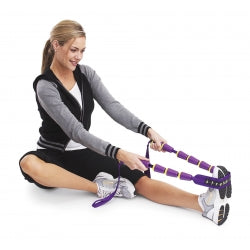FREE SHIPPING ON ORDERS OVER $25*
FREE SHIPPING ON ORDERS OVER $25*

Athletes who participate in sports in which they do a lot of jumping like basketball, volleyball, and long jump may experience a painful condition known as Jumper’s Knee. Jumper’s knee, or patellar tendonitis, is pain in the tendon which attaches the knee cap (patella) to the top of the shin bone (tibia).
Jumper’s knee is typically an overuse injury caused by repetitive strain placed on the patellar or quadriceps tendon during jumping but can affect athletes in “non-jumping” sports as well.
Some of the risk factors that contribute to jumper’s knee are increased body weight, being bow-legged or knock-kneed, having an abnormally high or low kneecap, and having legs of unequal length. Males are twice as likely as females to be afflicted by jumper’s knee. An athlete who has tight leg muscles and reduced flexibility in the thighs and hamstrings can have a muscle imbalance which can cause jumper’s knee pain.
Other factors that can contribute to jumper’s knee are the use of steroids which often results in weaker muscles and tendons and being afflicted with rheumatoid arthritis which causes inflammation of the knee joint.
Jumper’s knee typically consists of pain at the bottom front of the kneecap over what is called the lower pole of the patella. The bottom of the patella will be very tender when pressing in, and activities like jumping are painful. An athlete suffering from jumper’s knee is likely to experience aching and stiffness after exercise and it is possible that the affected tendon may appear larger than the tendon on the unaffected side.
It is important to pay attention to knee pain. Jumper’s knee may initially appear to be an annoying minor injury that is not very concerning. As it may not be a debilitating injury, many athletes may continue to train and compete on it. However, neglecting jumper’s knee can cause this minor knee pain to become chronic and difficult to treat.
Ideally, athletes should prevent jumper’s knee pain before it starts. Suggestions for preventing jumper’s knee include:
If an athlete is experiencing early stages of Jumper’s Knee pain, they can usually treat themselves. A more severe injury may require longer rest and could result in surgery.
Targeted muscles for healing and preventing Jumper’s Knee

Stretching exercises targeting the gluteus medius, piriformis, hamstrings, and quads will help to ensure flexibility along the posterior chain and can help to prevent future Jumper’s Knee issues.
The patented StretchRite® system features a non-elastic strap which makes it easy to perform each stretch properly and effectively. Six ergonomically-shaped handgrips offer a comfortable non-cinching hold and make it simple to adjust tension during the stretch. The handgrips also serve as visual feedback helping athletes safely stretch and monitor their progress. The StretchRite offers a comfortable, more effective stretch which improves flexibility and promotes healing in the knee.
Successful strengthening programs for Jumper’s Knee have focused on gastroc & soleus muscles as well as proprioceptive training.
Massage and myofascial release can often relieve muscle tension and create tissue mobility contributing significantly towards increasing flexibility and reducing the occurrence of Jumper’s Knee.
The ProStretch Pro Massage Rollers unique design allow you to increase circulation and release trigger points.
For increased flexibility, circulation and performance consider massaging the:
The post An Athlete’s Guide to Jumper’s Knee appeared first on Medi-Dyne.


